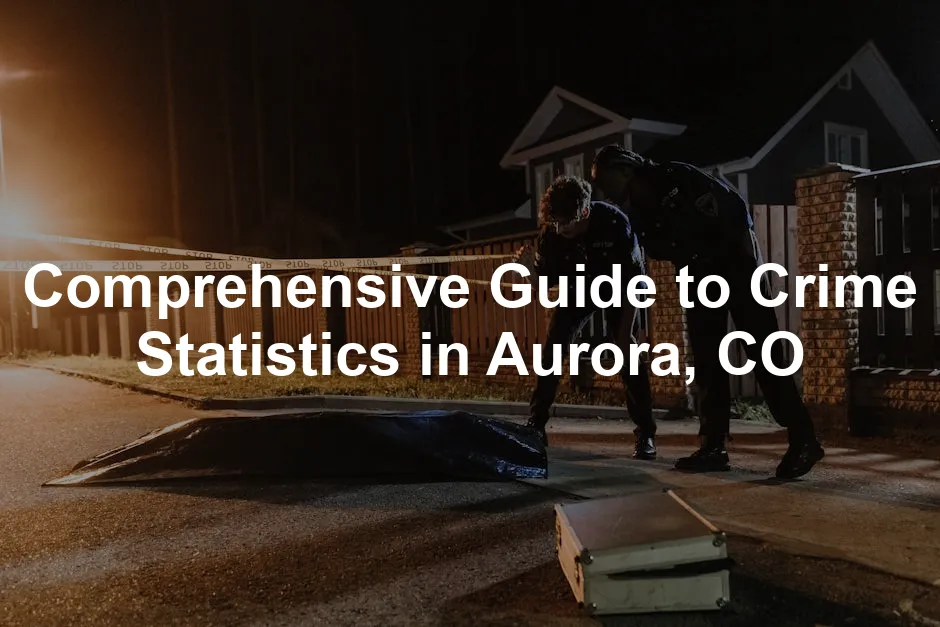Introduction
Welcome to Aurora, Colorado, where the crime statistics paint quite a vivid picture. Understanding these figures is crucial for residents, prospective movers, and policymakers alike. Why? Because crime data reveals trends that can affect safety, property values, and community well-being. For residents, knowing crime rates can boost awareness and preparedness. It keeps you informed about the safety of your neighborhood. Potential movers? Well, you want to know if your dream home is in a safe area or a hotspot for trouble. And for policymakers, accurate crime data helps shape effective strategies for law enforcement and community support. In exciting news, the Aurora Police Department has launched an Online Transparency and Accountability Portal. This nifty tool provides the public with continuously updated crime data. It’s like having a crime report at your fingertips! The portal allows residents to filter data by crime type, location, and time period. This initiative aims to enhance trust and communication between the police and the community. To enhance your home security, consider investing in a Home Security Camera System. With high-resolution video feeds and motion detection, it’s perfect for keeping an eye on your property, especially in neighborhoods where crime rates are higher. Throughout this article, we’ll break down Aurora’s crime landscape, including historical trends, current crime rates, and neighborhood variations. Buckle up; we’re about to uncover the stories behind the numbers!
Overview of Aurora’s Crime Landscape
Historical Context
Let’s rewind the clock and look at how crime has evolved in Aurora over the past decade. It’s been a rollercoaster ride! Over the last ten years, Aurora has seen fluctuations in crime rates, with some categories experiencing sharp increases. For instance, violent crime surged notably from 2015 to 2018, raising eyebrows and concerns among residents. However, recent years have shown some promising trends. For instance, some statistics suggest that overall violent crime may be decreasing. Property crimes, particularly auto theft, have also seen a decline in certain neighborhoods. Despite these positive changes, it’s essential to stay vigilant as crime data can shift rapidly due to various factors like economic conditions and community engagement.Current Crime Rates
Now, let’s dive into the nitty-gritty of current crime rates in Aurora. According to the latest reports from the FBI, Aurora has a crime rate of 53 per 1,000 residents, significantly higher than the state and national averages. In fact, the chance of becoming a victim of either violent or property crime in Aurora is roughly 1 in 19. Breaking it down further, the violent crime rate stands at about 10.74 per 1,000 residents. This includes categories such as murder, rape, robbery, and assault. For 2022, Aurora recorded 54 murders, 296 rapes, 827 robberies, and a staggering 3,049 assaults. On the property crime front, the city faced a whopping 16,607 incidents, resulting in a property crime rate of around 42.20 per 1,000 residents. When comparing these figures to state and national averages, it’s clear that Aurora’s crime rates are concerning. The state average for violent crime is significantly lower at 1,077 per 100,000 residents, while the national average hovers around 493 per 100,000 residents, making Aurora a notable outlier in terms of safety. So, what does this all mean? For residents and those considering a move to Aurora, these statistics underscore the importance of staying informed and engaged with local safety initiatives. Understanding crime trends allows for better decision-making and fosters a sense of community responsibility. As we continue this guide, we’ll delve deeper into specific crime statistics, offering a detailed breakdown of violent and property crime rates across different neighborhoods in Aurora. Stay tuned!
Detailed Breakdown of Crime Statistics
Violent Crime Statistics
Overall Violent Crime Rate
Aurora, Colorado, faces a challenging landscape when it comes to violent crime. The total violent crime rate stands at approximately 10.74 per 1,000 residents. This figure translates to a total of 4,226 reported violent crimes in the city. Breaking it down further, the numbers show a stark reality:- Murders: 54
- Rapes: 296
- Robberies: 827
- Assaults: 3,049
Neighborhood Variations
Not all neighborhoods in Aurora experience crime at the same rate. Some areas are noticeably safer than others. For instance, neighborhoods like Aurora Highlands and Tallyn’s Reach have lower crime rates, offering residents a more peaceful living environment. Conversely, neighborhoods such as Sunny Vale and Utah Park report higher levels of violent crime, drawing attention to the disparities within the city. In neighborhoods with elevated crime rates, several factors could be contributing to the uptick. Economic challenges, lack of community resources, and social issues may play a significant role. As residents, understanding these dynamics can help in advocating for better resources and safety measures in more troubled areas. To ensure personal safety in these neighborhoods, consider carrying a Personal Safety Alarm Keychain. It’s a small, portable device that can emit a loud sound to alert others in case of an emergency.
Property Crime Statistics
Overview of Property Crime Rates
When it comes to property crime, Aurora is grappling with a substantial rate of 42.20 per 1,000 residents. This translates to a staggering 16,607 reported property crimes in the city. The breakdown includes:- Burglary: 1,821
- Theft: 7,965
- Motor Vehicle Theft: 6,821

Neighborhood Insights
Similar to violent crime, property crime rates vary across Aurora’s neighborhoods. Areas like Meadow Wood and Southshore are relatively safer, while neighborhoods such as North Aurora and Murphy Creek experience higher rates of property crime. The reasons behind these trends can be multifaceted. Economic factors, community engagement, and even the presence of local businesses can influence crime rates. For instance, neighborhoods with more businesses may experience an uptick in thefts, while those that foster community engagement often report lower crime rates. Understanding these neighborhood-specific trends is crucial. Residents can work together to increase awareness, create neighborhood watch programs, and advocate for local law enforcement to focus resources where they are needed most. Being proactive not only enhances safety but also fosters a sense of community and belonging. In summary, comprehending crime statistics at both the city and neighborhood levels is vital for Aurora’s residents. By staying informed and engaged, individuals can work toward a safer environment for all.
Comparative Analysis
Comparison with Other Cities
When it comes to crime rates, Aurora, Colorado, stands out like a sore thumb. But how does it stack up against cities of similar size? Let’s break it down. Aurora has a crime rate of 53 per 1,000 residents. This number thrusts it into the spotlight, making it one of the more dangerous cities in the U.S. In fact, around 95% of communities in Colorado report lower crime rates. Let’s compare Aurora with other cities across the nation.| City | Total Crime Rate (per 1,000) | Violent Crime Rate (per 1,000) | Property Crime Rate (per 1,000) |
|---|---|---|---|
| Aurora, CO | 53 | 10.74 | 42.20 |
| Colorado Springs, CO | 20.6 | 5.3 | 15.3 |
| Wichita, KS | 32.9 | 8.3 | 24.6 |
| Omaha, NE | 29.5 | 6.7 | 22.8 |
| Lincoln, NE | 24.4 | 3.9 | 20.5 |
| Denver, CO | 35.3 | 9.0 | 26.3 |

Trends Over Time
Looking back at crime statistics in Aurora reveals a picture that’s constantly changing. Over the past several years, the city has seen both increases and decreases in crime rates, depending on the type of crime. From 2019 to 2022, violent crimes surged by about 6.6%, with property crimes rising by 8.5%. However, recent reports indicate a slight decline. For instance, in 2024, property crimes have shown a decrease of 31% compared to 2023, particularly in motor vehicle thefts. Despite the ups and downs, certain crime types have consistently raised concerns. Motor vehicle thefts have been particularly rampant, making it a hot topic in local discussions. The chance of having your vehicle stolen in Aurora is about 1 in 58. Yikes! On the flip side, certain crime categories, like residential burglaries, have seen improvements, indicating that local law enforcement efforts may be paying off. Understanding these trends is essential for residents to stay informed and proactive about their safety.
Community Response to Crime
Law Enforcement Initiatives
The Aurora Police Department (APD) has rolled out comprehensive strategies to tackle crime head-on. One initiative making waves is the Online Transparency and Accountability Portal. This portal offers residents access to constantly updated crime data, helping them stay informed about what’s happening in their neighborhoods. Interim Police Chief Heather Morris emphasized the importance of this portal, stating, “The Aurora Police Department’s Online Transparency and Accountability Portal represents our commitment to broader information sharing with the community we serve.” This tool allows residents to filter crime data by various categories, empowering them to stay vigilant in their communities. In addition to the portal, the APD has embraced community policing. This approach fosters better relationships between officers and residents, making it easier for law enforcement to address local concerns. Outreach programs aimed at educating the public about crime prevention strategies have also been implemented, enhancing community safety and trust. To ensure your safety during emergencies, consider having an Emergency Preparedness Kit at home. It can provide peace of mind and ensure you’re ready for any situation.
Community Involvement
Community involvement is the backbone of any effective crime prevention strategy. Neighborhood watch programs are gaining traction, with residents banding together to keep an eye on their streets. These initiatives are vital, as they not only bolster security but also foster a sense of community. Residents have reported feeling safer in neighborhoods with active watch groups. Local testimonials highlight the positive impact of these programs, showcasing how community engagement can lead to a drop in crime rates. It’s a classic case of “many eyes are better than one.” In conclusion, understanding crime statistics in Aurora, CO, is not just about numbers—it’s about community, awareness, and proactive measures. With ongoing efforts from both law enforcement and residents, the goal is to create a safer environment for everyone.
Factors Influencing Crime Rates
Socioeconomic Factors
Economic conditions in Aurora play a crucial role in shaping crime rates. With a poverty rate hovering around 10%, the link between financial distress and criminal activity is hard to ignore. Higher unemployment rates often correlate with increased crime. When people struggle to find work, desperation can lead to poor decisions. Demographic data is also telling. Areas with higher population density often experience more crime. As families move into urban settings, the demand for resources increases, leading to competition and sometimes, conflict. For example, younger populations in Aurora may engage in more risky behaviors, impacting overall crime statistics.Drug-Related Crime
Aurora is not immune to the impact of drug use and trafficking on crime rates. The opioid epidemic has cast a long shadow over many communities, including this one. Drug-related offenses contribute significantly to the overall crime picture. Law enforcement has ramped up efforts to combat these issues, focusing on education and prevention. Local initiatives, like community outreach programs, aim to address drug abuse at its roots. The Aurora Police Department actively collaborates with health services to provide resources for those struggling with addiction. “We’re not just chasing down criminals; we’re trying to find solutions,” said Police Chief Morris. This proactive approach is crucial in turning the tide against drug-related crime. Through community support and law enforcement initiatives, Aurora is working toward a safer environment. By understanding the socioeconomic factors and addressing drug-related issues, residents can foster a community where safety is a shared responsibility.
Conclusion
In summary, the crime statistics in Aurora, CO, reveal a landscape that demands attention. With a crime rate of 53 per 1,000 residents, Aurora stands out among the more dangerous cities in the U.S. The likelihood of becoming a victim of violent or property crime is concerning, with a staggering chance of 1 in 19. Understanding these numbers is essential for residents and potential movers. Key insights show that while violent crime rates are high, some neighborhoods fare better than others. For instance, areas like Aurora Highlands and Tallyn’s Reach offer a safer environment compared to Sunny Vale and Utah Park. Staying informed about these variations can help residents make better choices regarding their safety and community involvement. Community awareness is crucial in addressing crime effectively. Residents are encouraged to engage with local initiatives, such as neighborhood watch programs, which have proven effective in enhancing safety. The proactive measures taken by the Aurora Police Department, including the Online Transparency and Accountability Portal, are commendable. This resource provides up-to-date crime data, allowing residents to stay informed about local incidents. In a world where safety concerns loom large, it’s vital for residents to take an active role in their communities. By utilizing available resources, staying informed, and participating in local initiatives, residents can contribute to a safer Aurora. The more engaged the community becomes, the stronger the partnership with law enforcement will be. Together, they can work towards reducing crime and fostering a safer environment for everyone.To ensure your vehicle’s safety, consider investing in a Car Steering Wheel Lock. It’s a simple yet effective measure to deter thieves.For a detailed analysis of safety in Fremont, you can check out the Fremont crime statistics.
What are the crime rates in Aurora compared to Colorado?
When comparing crime rates, Aurora’s statistics stand out significantly. The overall crime rate in Aurora is approximately 53 per 1,000 residents, which is notably higher than the Colorado average of 20.6 per 1,000. For violent crimes, Aurora’s rate is about 10.74 per 1,000, compared to Colorado’s 5.3 per 1,000. This stark contrast highlights the safety challenges faced by residents in Aurora.
What should new residents know about safety in Aurora?
New residents should be aware of the varying safety levels across neighborhoods. While some areas like Aurora Highlands and Southshore are relatively safe, neighborhoods such as North Aurora and Murphy Creek report higher crime rates. It’s essential to remain vigilant and take precautions, like securing homes and engaging with neighbors. Basic safety tips include being aware of your surroundings, locking doors, and getting involved in community watch programs.
How can residents get involved in preventing crime?
Residents can play an active role in crime prevention by engaging with local organizations and initiatives. Joining neighborhood watch groups is a fantastic way to foster community spirit while enhancing safety. Additionally, participating in local events and meetings can help residents voice their concerns and collaborate with law enforcement. Organizations like the Aurora Police Department offer programs aimed at educating the public about crime prevention strategies. Staying connected with community resources not only empowers residents but also strengthens the fabric of Aurora’s neighborhoods.
All images from Pexels




